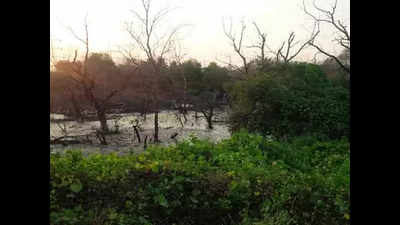Trending
This story is from October 17, 2020
Goa: Mangrove policy may focus on eco-tourism
The comprehensive draft mangrove management plan focusses on tapping eco-tourism and has recommended re-assessment of the mangrove cover of the Goa coast to ascertain changes in composition, structure and spice diversity that has occurred over the years since the last assessment.

Picture used for representational purpose only
PANAJI: The comprehensive draft mangrove management plan focusses on tapping eco-tourism and has recommended re-assessment of the mangrove cover of the Goa coast to ascertain changes in composition, structure and spice diversity that has occurred over the years since the last assessment.
The draft also proposes conservation of crocodiles and the Kandelia candel mangrove species.
“Many mangrove areas are potentially suitable for eco-tourism. The indigenous biodiversity offers great attraction to tourists and are valuable assets in ecotourism economy. Well planned eco-tourism could provide economic and political incentives for proper management and conservation,” states the draft plan.
The draft plan has recommended conservation of crocodiles (Crocodilus palustris species). It mentions that in Goa, this species is found in the mangroves of the Cumbharjua canal. Along the west coast, the species has been reported in rivers, irrigation canal, ponds, lakes, reservoirs, etc, in Gujarat, Maharashtra, Karnataka and Kerala.
It has been reported that this species has discontinuous distribution along the Indian coast, particularly along the west coast of India.
“Only in Goa, this is a unique ecological adaptation of this species, and hence efforts may be made to conserve and protect the mangrove area inhabiting this species,” states the draft plan.
In Goa, it is found along the Zuari,
“As it is growing luxuriantly in Mandovi–Zuari, a substantial portion of mangrove area should be reserved and protected,” the draft plan states.
Last month, the state government had constituted a committee headed by Dr Simon D'Souza, former chairperson of Goa State Pollution Control Board, to prepare the mangrove management plan.
The objectives of the plan is to manage and protect mangrove areas for biodiversity conservation, coastal stabilisation, erosion control, etc, and to strengthen capacities of the institutions responsible for mangrove management.
Other objectives of the plan are to promote community participation in mangrove resource management for improved livelihoods, ensure measures to address threats from climate change and human activities, promote sustainable tourism and recreation in mangrove areas, and to further research and education.
The mangrove management plan provides an overview of the potential direct and indirect impacts that may likely to occur to mangrove and its biodiversity. It includes a broad range of management measures and techniques that should be promoted to maximize the benefits and help secure the long-term sustainable use of mangroves for the people who rely on them.
The plan will help to maintain the abundance, diversity, geographic distribution and productivity of mangroves in the state.
The draft also proposes conservation of crocodiles and the Kandelia candel mangrove species.
“Many mangrove areas are potentially suitable for eco-tourism. The indigenous biodiversity offers great attraction to tourists and are valuable assets in ecotourism economy. Well planned eco-tourism could provide economic and political incentives for proper management and conservation,” states the draft plan.
The draft plan has recommended conservation of crocodiles (Crocodilus palustris species). It mentions that in Goa, this species is found in the mangroves of the Cumbharjua canal. Along the west coast, the species has been reported in rivers, irrigation canal, ponds, lakes, reservoirs, etc, in Gujarat, Maharashtra, Karnataka and Kerala.
The draft also recommendes conservation of the Kandelia candel mangrove species.
It has been reported that this species has discontinuous distribution along the Indian coast, particularly along the west coast of India.
“Only in Goa, this is a unique ecological adaptation of this species, and hence efforts may be made to conserve and protect the mangrove area inhabiting this species,” states the draft plan.
In Goa, it is found along the Zuari,
Mandovi and Cumharjua canal, while small patches of this species are reported from Ratnagiri in Maharashtra, Honnavar in Karnataka and Kannur in Kerala coast. Along the east coast, it has been reported from Tamil Nadu, Odisha and Andhra Pradesh.
“As it is growing luxuriantly in Mandovi–Zuari, a substantial portion of mangrove area should be reserved and protected,” the draft plan states.
Last month, the state government had constituted a committee headed by Dr Simon D'Souza, former chairperson of Goa State Pollution Control Board, to prepare the mangrove management plan.
The objectives of the plan is to manage and protect mangrove areas for biodiversity conservation, coastal stabilisation, erosion control, etc, and to strengthen capacities of the institutions responsible for mangrove management.
Other objectives of the plan are to promote community participation in mangrove resource management for improved livelihoods, ensure measures to address threats from climate change and human activities, promote sustainable tourism and recreation in mangrove areas, and to further research and education.
The mangrove management plan provides an overview of the potential direct and indirect impacts that may likely to occur to mangrove and its biodiversity. It includes a broad range of management measures and techniques that should be promoted to maximize the benefits and help secure the long-term sustainable use of mangroves for the people who rely on them.
The plan will help to maintain the abundance, diversity, geographic distribution and productivity of mangroves in the state.
End of Article
FOLLOW US ON SOCIAL MEDIA










